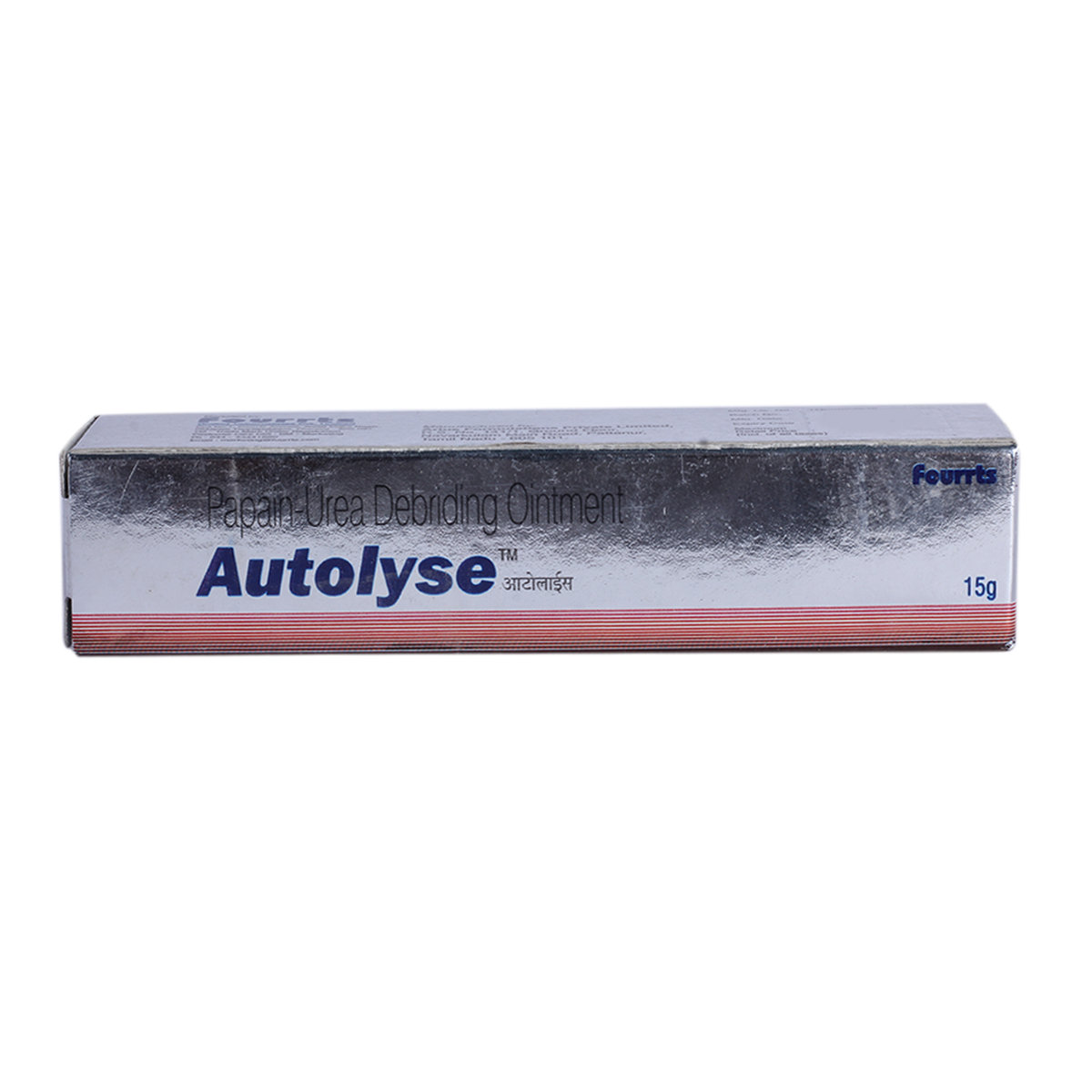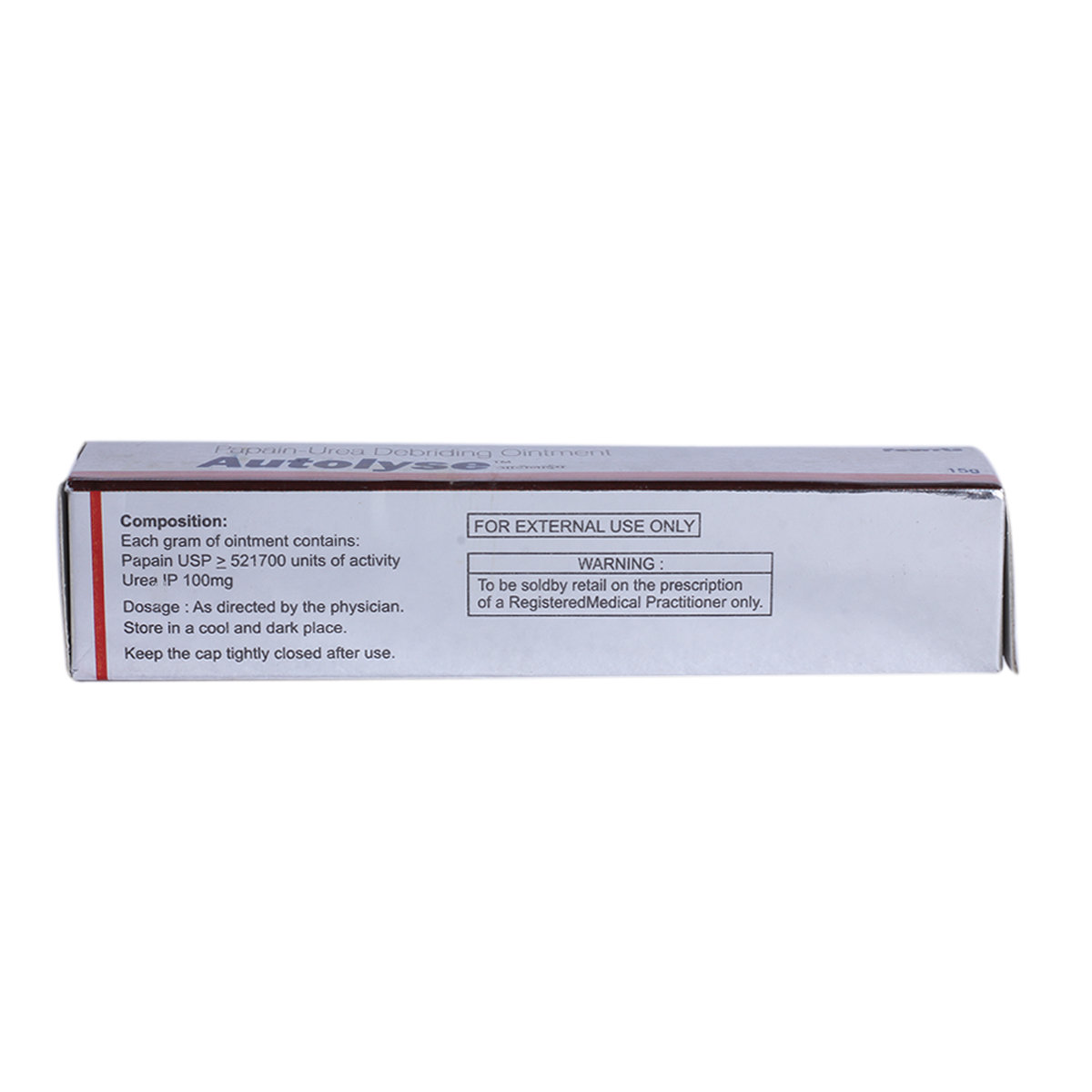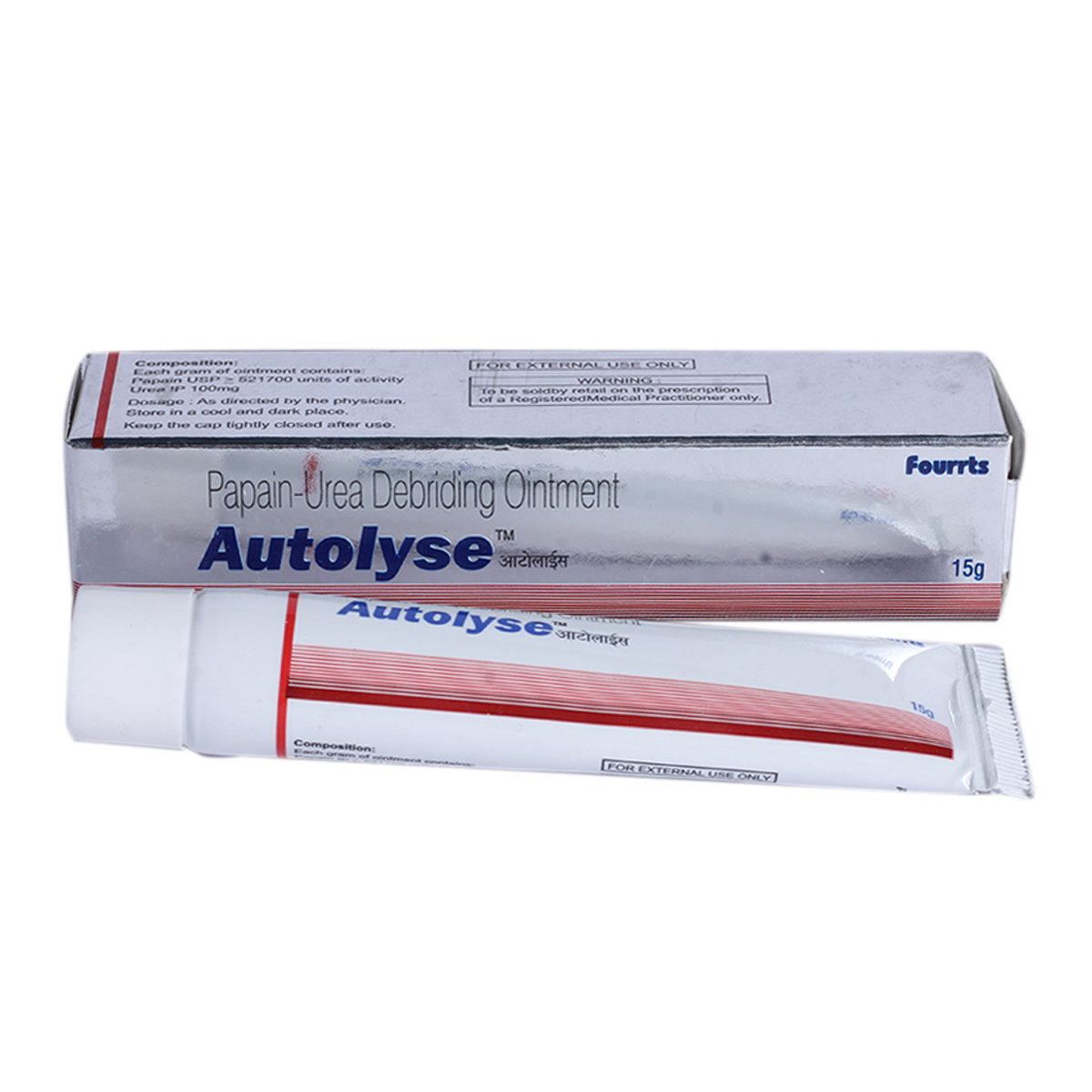Autolyse Ointment 15 gm






MRP ₹231.5
(Inclusive of all Taxes)
₹34.7 Cashback (15%)
Provide Delivery Location
Online payment accepted
 Prescription drug
Prescription drugWhats That
Composition :
Manufacturer/Marketer :
Consume Type :
Return Policy :
Expires on or after :
About AUTOLYSE OINTMENT
AUTOLYSE OINTMENT belongs to the class of medications called 'Debridement agents' used to remove dead skin, thereby improving healing. It also helps thin the pus in lesions (ulcers, cysts, bedsores, surgical wounds).
AUTOLYSE OINTMENT contains Papain and Urea. These two medicines are keratolytic agents, increase moisture in the skin, and dissolve the keratin (protein present on the skin's outer layer). This effect makes dead skin cells fall off and accelerate healing. It also has an emollient effect and helps to soften the skin.
You should use this medicine exactly as prescribed by the doctor. The common side effects of AUTOLYSE OINTMENT are a burning sensation, itching, and irritation in the treated area. These side effects are usually mild and temporary. However, if these side effects persist or worsen, inform your doctor immediately.
It is not recommended to take AUTOLYSE OINTMENT if you are allergic to any contents of it. Before taking AUTOLYSE OINTMENT, inform your doctor if you have liver or kidney disease and poor blood circulation. Do not use this medication on skin cuts, infections, or sores. AUTOLYSE OINTMENT should be used with caution in pregnant women, breastfeeding mothers, and older people. It is not recommended for use in children less than two years. AUTOLYSE OINTMENT may not interact with alcohol and may not affect your driving ability.
Uses of AUTOLYSE OINTMENT
Directions for Use
Medicinal Benefits
AUTOLYSE OINTMENT belongs to the class of medications called 'Debridement agents' used to remove dead skin and promote wound healing. AUTOLYSE OINTMENT contains Papain and Urea, which help remove dead skin from wounds and speed up recovery. It also helps thin the pus in lesions (ulcers, cysts, bedsores, surgical wounds). These two medicines increase moisture in the skin and dissolve keratin (a protein on the skin's outer layer). This effect makes dead skin cells fall off and accelerate healing. It also has an emollient effect and helps to soften the skin.
Storage
- Skin rash caused by allergies is due to irritants or allergens. Therefore, avoid contact with such irritants.
- Consult your doctor for proper medication and apply an anti-itch medication. Follow the schedule and use the medication whenever needed.
- Protect your skin from extreme heat and try to apply wet compresses.
- Soak in the cool bath, which gives a soothing impact to the affected area.
- Report the itching to your doctor immediately; they may need to change your medication or dosage.
- Use a cool, damp cloth on the itchy area to help soothe and calm the skin, reducing itching and inflammation.
- Keep your skin hydrated and healthy with gentle, fragrance-free moisturizers.
- Try not to scratch, as this can worsen the itching and irritate your skin.
- If your doctor prescribes, you can take oral medications or apply topical creams or ointments to help relieve itching.
- Track your itching symptoms and follow your doctor's guidance to adjust your treatment plan if needed. If the itching persists, consult your doctor for further advice.
- Swelling of mouth must be reported to your doctor immediately for various underlying reasons.
- Avoid consuming alcohol, dairy products and processed and fried foods.
- Eat a diet containing vitamin B-rich foods like peas, bananas, oranges, etc., or take supplements.
- Avoid touching your mouth with your hands frequently without washing.
- Eat soft and less spicy foods that can be swallowed without chewing.
Drug Warnings
AUTOLYSE OINTMENT is for topical (skin) use only. Do not use the medicine in and around your eyes. If the medicine accidentally gets into your eyes, nose, mouth, or genitals, rinse it with water thoroughly. It should not be given to children with a fever, especially if they have flu symptoms or chickenpox. AUTOLYSE OINTMENT may increase skin sensitivity to the sun, so take necessary precautions while going outside and avoid tanning beds or sunlamps. If you notice any persistent skin irritation or worsening of the skin disease, stop using AUTOLYSE OINTMENT and immediately inform your doctor.
Drug-Drug Interactions
Drug-Drug Interactions
Login/Sign Up
Drug-Food Interactions
Drug-Food Interactions
Login/Sign Up
Diet & Lifestyle Advise
- Use mild soap while taking baths and prefer warm baths.
- Avoid harsh products on your skin.
- Do not scratch or pick your skin to avoid infecting the affected area.
- Manage stress, eat healthily, drink plenty of water, exercise regularly, and get plenty of sleep.
- Limit food intake that might trigger allergies, such as dairy products, soy, eggs, and nuts.
- Avoid consuming foods with excess sugar, as it may flare up inflammation.
- Include fruits, vegetables, whole grains, healthy fats, and fish.
- Avoid getting in contact with harsh soaps, detergents, and rough fabrics.
- Wear clothes with long sleeves, a hat, and sunscreen with high SPF while outdoors.
- Avoid tanning booths and sunlamps.
Side Effects of AUTOLYSE OINTMENT
- Burning sensation
- Itching of treated skin
- Skin irritation
Habit Forming
Therapeutic Class
All Substitutes & Brand Comparisons
RX
Debrivoid Ointment 15G
Centaur Pharmaceuticals Pvt Ltd
₹246
(₹14.77/ 1gm)
6% COSTLIER
Product Substitutes
Drug-Diseases Interactions
Drug-Diseases Interactions
Login/Sign Up
FAQs
AUTOLYSE OINTMENT contains Papain and Urea. These two medicines are keratolytic agents (soften, separate, and peel off the horny layer of skin). They dissolve the keratin (protein present on the outer layer of skin), remove dead skin cells, and soften the skin.
The common side effects of AUTOLYSE OINTMENT are a burning sensation, itching, and irritation in the treated area. These side effects are usually mild and temporary. However, if any of these side effects persist or worsen, inform your doctor immediately.
It is advised to avoid using other topical medicines on the affected area while using AUTOLYSE OINTMENT. So, inform your doctor before using any medications while using the AUTOLYSE OINTMENT. If the doctor prescribes other skin creams or ointments along with AUTOLYSE OINTMENT, you should maintain an interval of at least 30 min between the two medications.
AUTOLYSE OINTMENT should not be used to treat diaper rash or redness. It is not recommended for use in children below 2 years of age.
AUTOLYSE OINTMENT is for topical use (for skin) only. Do not use the AUTOLYSE OINTMENT on the skin that is red, swollen, oozing, and infected, and avoid contact with eyes, nose, mouth, and genitals. It can make your skin more sensitive to the harmful effects of sunlight. So, using sunscreen and wearing protective clothing while using AUTOLYSE OINTMENT is advised. It is recommended to avoid tanning booths and sunlamps. Please do not use it on larger areas and for prolonged periods unless prescribed by the doctor.
Drug-Drug Interactions Checker List
- HYDROGEN PEROXIDE
- SILVER NITRATE
- SILVER
- SILVER SULFADIAZINE
- THIMEROSAL
Special Advise
- Before applying AUTOLYSE OINTMENT, avoid using hydrogen peroxide to clean your wound, as it might affect the effectiveness of AUTOLYSE OINTMENT.
- If there is no improvement in your condition after 4-6 weeks of treatment with AUTOLYSE OINTMENT, consult your dermatologist.
Disease/Condition Glossary
Debridement: It is a procedure for treating wounded skin. These agents help to remove dead skin and tissues from wounds, including ulcers, cysts, bedsores, and surgical wounds. Sometimes, it is also used to remove foreign material from tissues. It also helps to speed up the healing process of wounds.

Have a query?
Buy best Skin Disorders products by
Sun Pharmaceutical Industries Ltd
Glenmark Pharmaceuticals Ltd
Cipla Ltd
Oaknet Healthcare Pvt Ltd
Ranbaxy Laboratories Ltd
Salve Pharmaceuticals Pvt Ltd
Torrent Pharmaceuticals Ltd
Dr Reddy's Laboratories Ltd
Karlin Pharmaceuticals & Exports Pvt Ltd
Merck Ltd
Micro Labs Ltd
Abbott India Ltd
Alkem Laboratories Ltd
East West Pharma India Pvt Ltd
Intas Pharmaceuticals Ltd
Leeford Healthcare Ltd
Mohrish Pharmaceuticals Pvt Ltd
P and P Dermaceuticals Pvt Ltd
Surecare Pharma Pvt Ltd
Wockhardt Ltd
Canixa Life Sciences Pvt Ltd
Geno Pharmaceuticals Pvt Ltd
GlaxoSmithKline Pharmaceuticals Ltd
Apex Laboratories Pvt Ltd
Dabur India Ltd
Fourrts India Laboratories Pvt Ltd
Fulford India Ltd
Indi Pharma Pvt Ltd
Lupin Ltd
Mankind Pharma Pvt Ltd
Monichem Healthcare Pvt Ltd
Novartis India Ltd
NuLife Pharmaceuticals
Saf Fermion Ltd
Wallace Pharmaceuticals Pvt Ltd
A. Menarini India Pvt Ltd
Acme Corporation
Ajanta Pharma Ltd
Alembic Pharmaceuticals Ltd
An Pharmaceuticals Pvt Ltd
Apple Therapeutics Pvt Ltd
Biocon Ltd
Comed Chemicals Ltd
Dwd Pharmaceuticals Ltd
Dynamic Techno Medicals
E Merck India Ltd
H&H Pharmaceuticals Ltd
Hegde & Hegde Pharmaceutica Llp
Kaizen Pharmaceuticals Pvt Ltd
Klm Laboratories Pvt Ltd
Kremoint Pharma Pvt Ltd
Liva Health Care Ltd
Macleods Pharmaceuticals Ltd
Menarini India Pvt Ltd
Shalaks Pharmaceuticals Pvt Ltd
Stedman Pharmaceuticals Pvt Ltd
Unichem International
Yash Pharma Laboratories Pvt Ltd
Zee Laboratories Ltd
Adonis Laboratories Pvt Ltd
Alive Pharmaceutical Pvt Ltd
Amwill Healthcare Pvt Ltd
Apple Pharmaceuticals
Athens Labs Ltd
Aventis Pharma
Bayer Corporation
Bayer Pharmaceuticals Pvt Ltd
Bellissa Pharmaceuticals Pvt Ltd
Biochem Pharmaceutical Industries Ltd
Bion Therapeutics (I) Pvt Ltd
Blue Cross Laboratories Pvt Ltd
Cadila Healthcare Ltd
Cadila Pharmaceuticals Ltd
Centaur Pharmaceuticals Pvt Ltd
Concept Pharmaceuticals Ltd
Corona Remedies Pvt Ltd
Cosme Healthcare
DR Johns Lab Pharma Pvt Ltd
Dan Laboratories
Dermocare Laboratories Gujarat Llp
Dollar Company Pvt Ltd
Elder Pharmaceuticals Ltd
Emcee Pharmaceuticals (P) Ltd
Eskon Pharma
FDC Ltd
Fem Care Pharma Ltd
Finn Cosmeceutical Pvt Ltd
Galaxus Pharmaceuticals
Galaxy Biotech
Galderma India Pvt Ltd
Gary Pharmaceuticals Pvt Ltd
Gland Pharma Ltd
Gopish Pharma Ltd
Grefith Life Sciences Pvt Ltd
Ind Swift Laboratories Ltd
Indus Life Sciences Pvt Ltd
Insula Pharmaceuticals Pvt Ltd
Intermed Pharma Pvt Ltd
Intra Labs India Pvt Ltd
Janssen Pharmaceuticals Pvt Ltd
Alcohol
Safe if prescribed
AUTOLYSE OINTMENT may not interact with alcohol.
Pregnancy
Caution
AUTOLYSE OINTMENT contains urea, a Category C pregnancy drug that may cause harmful effects on the unborn baby. So, it is given to a pregnant woman only if the doctor thinks the benefits outweigh the risks.
Breast Feeding
Caution
It is not known whether AUTOLYSE OINTMENT can pass into breast milk. So, it is given to a breastfeeding mother only if the doctor thinks the benefits outweigh the risks.
Driving
Safe if prescribed
AUTOLYSE OINTMENT may not affect your ability to drive.
Liver
Caution
AUTOLYSE OINTMENT should be used with caution in patients with liver diseases. The dose may have to be adjusted by your doctor.
Kidney
Caution
AUTOLYSE OINTMENT should be used with caution in patients with kidney diseases. The dose may have to be adjusted by your doctor.
Children
Caution
AUTOLYSE OINTMENT is not recommended for children below two years. In children above two years, it is given only if the doctor thinks the benefits outweigh the risks.




